http://www.bbc.co.uk/worldservice/learningenglish/communicate/blog/student//images/hoian.jpg
Hoi An Ancient Town is an exceptionally well-preserved example of a South-East Asian trading port dating from the 15th to the 19th century. Its buildings and its street plan reflect the influences, both indigenous and foreign, that have combined to produce this unique heritage site.
oi An is a small town in Central Vietnam famous for its wooden houses, for its family chapels, for its Assembly Halls and for its silk shops.The town of Hoi An, known as Faifo in Europe, played a central role in the commerce between Vietnam and the rest of the world from the 16th to the 19th century. Nowadays the town attracts tourists from all the continents.
On the following I will give you a sneak preview of this town, one of Vietnam’s main attractions.
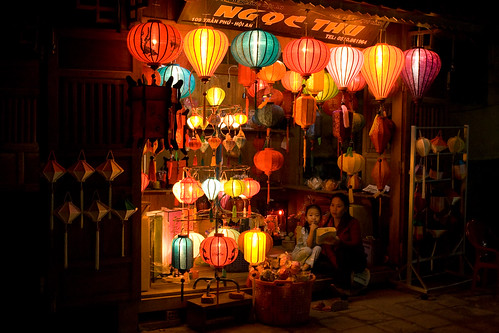
The city of Hoi An has no airport, and no train station[ either. The only way to get here is by road. You can hire a taxi from the neighboring city of Da Nang. This town does have an International Airport, with daily flights to and from Hanoi, Saigon, and other Vietnamese cities. Da Nang also has a train station, with trains to and from Hanoi (12- 22 hr), Saigon (17-22 hr) and Hue (3 hr). You can also get to Hoi An from Da Nang on a bus.
If you want to visit Hue, you can get there in three hours on a bus.
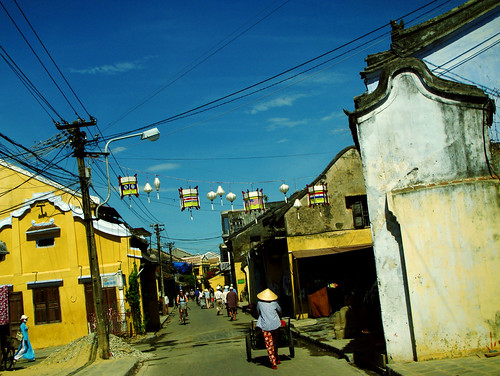
The accommodation offer in Hoi An is one of the most varied in Vietnam. You will find from cheap hotel [URL=“Hoi An, Old House Vietnam. VIRTOURIST.COM HOI AN”]](Hoi An, souvenir shop Vietnam. VIRTOURIST.COM HOI AN)for backpackers for a few euros, to expensive luxury resorts that can cost several hundred US dollars a night.
Hotels are in the outskirts of the town, but Hoi An is a small town. It should not be difficult to find a room, but it is always better to book in advance. If you are good at bargaining, you can get a very good deal for a nice hotel room. Thanks to the popularity of Hoi An among foreign tourists, new hotels are being inaugurated every season.
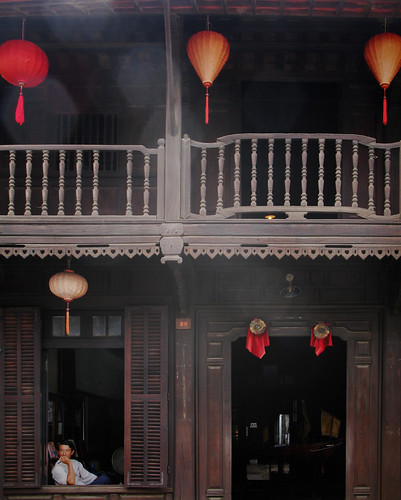
This bridge on a small stream was built by the Japanese community back in 1593. It links the Japanese and the Chinese quarters. On both ends of the bridge there are altars with guardians; dogs on one side, and monkeys on the other one. In the middle of the bridge there is a small shrine. This covered bridge is one of Hoi An’s main attractions. It is locally known as Chua Cau (or the Pagoda Bridge). On the other side of the bridge you will find art shops with paintings of local artists for sale.
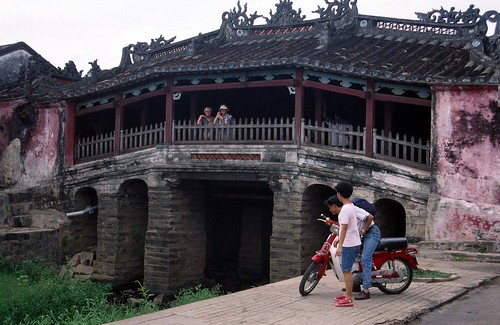
To move around Hoi An you can walk, rent a bicycle or take a cyclo. Hoi An is a rather small town, walking from one end to the other will take you less than half an hour. The main attractions are in the center of the town, most of them in a broad street that starts in the local market.
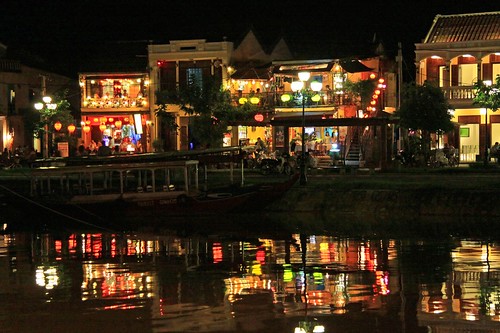
The best time to visit Hoi An is during the dry season, that goes from January to September. Temperatures are mild year round. In summer it can be somewhat hot.
The rainy season goes from October until December. Tropical showers may make your travels [to Hoi An unpleasant. If you get caught on a tropical storm, buses, trains and planes may be cancelled.
Whenever you feel hungry, go to the local market, and order one of the fast snacks. Stalls serve food all day long. Eating in the local market is something not many tourists do. I am sure the Vietnamese ladies will be pleased to serve you.
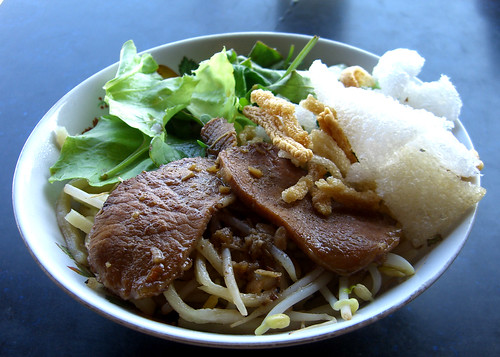
![]()
Cau Lau is a traditional Hoi An dish. Just about every restaurant offered it - the dish had promise but even after trying it at several places, none of the times rose to anything more than interesting.
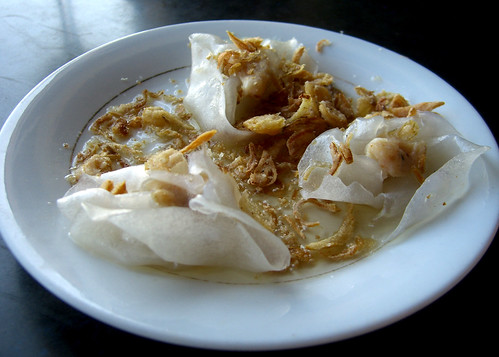
![]()
A Hoi An speciality. “White Rose, consisting of rice dumplings steamed with pork and shrimp inside, is similar to Chinese Dim Sum.” Makes sense since there was a strong historical presence of Chinese. I didn’t find this dish all that interesting or tasty.

![]()
A nice dessert of caramelized banana. Vietnam had some nice small bananas.
Haha, move to other face, Hoi An is also very famous for its tailor-made clothes. Most tourists who come to Hoi An buy, at least, one of the inexpensive silk dresses. Local tailors can prepare a custom made dress in less than 24 hours. The offer of dress shops is overwhelming. Ask fellow travellers [URL=“Hoi An, traditional assembly hall Vietnam. VIRTOURIST.COM HOI AN”]](Hoi An, Pagoda guard Vietnam. VIRTOURIST.COM HOI AN)for tips on where to find the best bargains. Most of the shops offer an excellent quality/price ratio.
Till the 20th century Hoi An used to have a very active port. There were canals parallel to the streets, and ships used to load and unload their goods right into the houses. Cargo ships had to call at the neighboring town of Da Nang when the river became silted up.
Here is Cua Dai beach, very near Hoi An
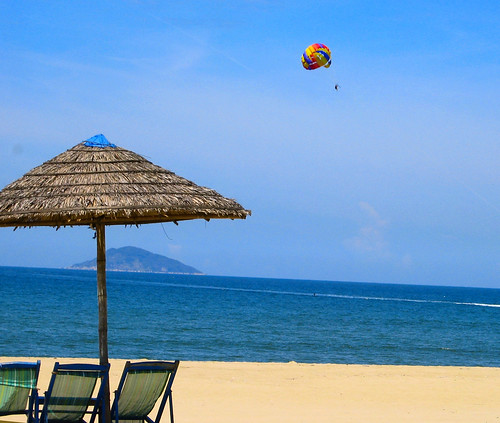
Although prices may rise in the near future, currently the cost of life in this exceptional city is still low. You can have an excellent dinner on a good restaurant by the sea for a few euros. Some of the luxury hotels [that have recently opened their doors may cost you several hundred dollars a night, but most of the places to sleep in town are still very affordable. Silk clothes and dresses can be bought at bargain prices. Renting a motorbike or a bicycle will cost you very little money too.
Here by general information about Hoi An will make u concern:
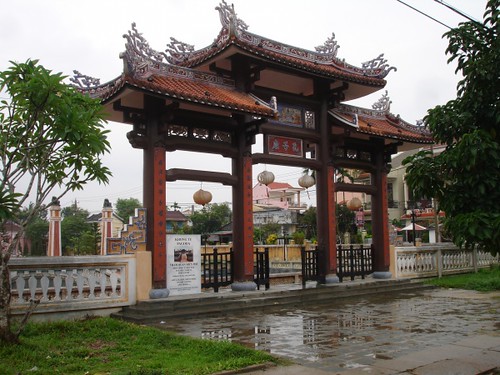
Hoi An Ancient Town
was added to Unesco’s World Heritage List in 1999.
Brief description by UNESCO: “Hoi An constitutes an exceptionally well preserved example of a South-East Asian trading port from the period of the 15th to 19th centuries. Its buildings and its street pattern reflect the influences, both indigenous and foreign, that combined to produce this unique heritage site”.
Distance: 140km from Hue or 32km from Danang
Access: by car/train/flight
Period: year round
Places of Interest
Japanese Covered Bridge
The Japanese covered bridge was built over a small canal in 1593 to link the Japanese quarter to the Chinese quarter. Designed and built by the Japanese community, the wooden structure has remained intact over the centuries.
Location: 1D Nguyen Thi Minh Khai
Access by walking: 10min
Tour: Half day tour
Duration of visit: 15min
Entrance fees: no
Period: year round
Local guide: not compulsory
Tan Ky house
This 18th century house blends Vietnamese, Chinese, and Japanese architectural styles. Chinese poems are written in mother-of-pearl are inscribed on the house’s columns; the roof is shaped in a distinctive Japanese, crab-shell shape; and the outer structure is Vietnamese in design. The house is well preserved and now appears almost exactly as it did in the early 19th century
Location: 101D Nguyen Thai Hoc
Access by walking: 10min
Tour: Half day tour
Duration of visit: 30min
Entrance fees: ticket pass
Opening hour: day time
Period: year round
Local guide: not compulsory
Fukien Chinese Congregation
This assembly hall was built in 1792. Later, it was transformed into a temple to worship Thien Hau, a native of Fukien province.
Location: in the town center
Access by walking: 15min
Tour: Half day tour
Duration of visit: 30min
Entrance fees: ticket pass
Opening hour: day time
Period: year round
Local guide: not compulsory
Thu Bon River
This river was once a busy trade port for ships coming from different countries. Now along the bank it is still as busy as it might have been , but the river is loose with traffic.
The ship building village is just 15 minutes away. Most of fishing boats in Hoi An are made here. Half an hour up the river from there is the pottery village. The way they make their products has never changed here over the centuries. A walk through this little village will bring us closer to the villagers who seem to be always busy with their business.
Location: The boat quay is located at Bach Dang St.
Access by walking: 15min
Tour: Half day tour
Duration of visit: 60min
Entrance fees:
Opening hour: day time
Period: year round
Local guide: not compulsory
Combination: Thanh Ha pottery village
Cua Dai Beach
The Bach of Cua Dai is about 3 km long, 1 km of which is ideal with white sand, clear, cool water and sloping sea floor. Therefore it is considered one of the most beautiful beaches in Central Viet Nam.
From very early in the morning, the living force of fishing villages is going on vividly and impressingly while early swimmers from town come to the beach in great numbers.
Location: 4km from Hoian
Access by walking: 15min
Entrance fees: no
Opening hour: day time
Period: year round
Local guide: not compulsory
Thanh Ha pottery village
Although it has experienced various changes of time, economic difficulties and foreign competition, the Thanh Ha l inhabitants are always trying to preserve a traditional profession, inherited from their ancestors.
The originality of their products resides in the color, durability, lightness and decoration. Depending on the time of burning and the temperature of kiln, the color can be changed from pink, pink yellow to red, light brown and ink-black. Thanks to the special technique of processing soil and the combination of successive manipulations, the durability of their products is nearly at the top rank compared to the others in the country and the brightness is same like enamel. Also, this pottery is lighter than the others. Especially, a soft and clear sound with echo can be heard by knocking on the product. Some products are offered on request or used for planting orchids, pot plants; they are decorated with the sink and float vignettes that are simple but very nice.
Distance: 3km west of Hoian
Access by car/bus: 10min
Tour: Half day tour
Duration of visit: 45min
Entrance fees: 20.000d
Opening hour: day time
Period: year round
Local guide: not compulsory
Combination: Boat trip on Thu Bon river
Hoian Lantern Work |pix album | | more text |
Hoi An people highly pride on their lantern. It is very simple and easy to do only with hard-work .In past, there was no “night of ancient city”. On the altar of each Hoi An family all hang two big lanterns with the beautiful Chinese words on two big lanterns with the beautiful Chinese words on, that is the name of each clan
Hoi An lantern is various size and shape, from normal lantern to dragon lantern or fish lantern with full of color. It is interesting that the locals preserve a custom so that all families light lanterns in the night of ancient city (monthly 14th lunar calendar)
Distance: 2km from the town center
Access by car/bus: 5min
Tour: Guests enjoy making lantern.
Duration of visit: 45min
Entrance fees: included in package
Opening hour: day time
Period: year round
Local guide: not compulsory
Cham Island
Known as “Cu lao Cham” by the locals, the island is famous as a source of swifts’s nests, which used to be speciality for the ancient royals. It is also an ideal place for fishing and visits to fishing villages.
Distance: 21km from Hoian town
Access by boat: 3h
Tour: Full day tour
Duration of visit:
Entrance fees:
Period: year round
Local guide: not compulsory
Others Chinese Congregations
- Fujian Congregation was built in 1792. Later, it was transformed into a temple to worship Thien Hau, a deity who was born in Fujian province ( 35Tran Phu str.)
- Cantonese Congregation was founded in 1786. The main alter is dedicated to Quan Cong, a deity sympolizing the loyalty (176D Tran Phu )
- Hainan Congregation was built in 1883 as a memorial to the 108 merchants from Hainan island who were mistaken for pirates and killed in the area (Tran Phu str.)
- Chaozhou Congregation was built in 1776. There is some outstanding woodcarvings on the beams, walls and altar. (Opposite 157D Nguyen Duy Hieu str.)
Tra Que Vegetables Growing Village
The occupation of planting vegetables in Tra Que has come into being since first fishmen chose land by Tra Que lagoon for settlement. Today, Tra Que vegetables are intergral to meals of Hoian families as well as in Hoian specialities such as Cao Lau, Quang noodles…
The country road to Tra Que leading along rice paddies with beautiful & peaceful landscapes make a good option for hiking or biking. At Tra Que, great photos of vegetable garden can be shot.
Distances: 3km from Central Hoian.
Access: 10 min biking.
Entrance fee: no.
Located by riverside, just 3km from Central Hoian, Thanh Nam fishing village is an ideal site for photo hunters, especially in the afternoon with fishing activities on the river at sunset. At the village, visitor can also explore various fishing utensils on display.
Distances: 3km from Central Hoian.
Access: 10min biking.
Entrance fee: no.
Best visit at Sunset or Sunrise.
Chinese All-Community
This construction, also known as Chua Ba, founded in 1773, was used by all five Chinese congregations in Hoian: Fujian, Cantonese, Hainan, Chaozhou and Hakka. The pavilions off the main courtyard incorporate 19th century French elements.
For more information or some questions asking, don’t hesitate to send me messages or via http://www.vnviptour.com/](Hoi An, barber shop Vietnam. VIRTOURIST.COM HOI AN).
Thank you for reading.
Ann